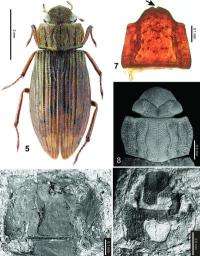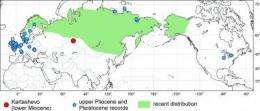A living species of aquatic beetle found in 20-million-year-old sediments

The fossil beetle discovered in the 16-23 million years old sediments of the Irtysh River in southern Siberia belongs to the modern species Helophorus sibiricus, a member of the water scavenger beetles (Hydrophiloidea), which is at present widely distributed in Eurasia and reaches even North America. The species was originally described in 1860 by the Russian entomologist Victor Motschulsky based on specimens collected at Lake Baikal. It is aquatic and inhabits various kinds of standing waters, predominantly the grassy temporary pools. Larvae are unknown so far, but are supposed to be terrestrial and predaceous, preying on various invertebrates, as in most other species of the genus.
The Siberian fossil provides new data for the long-lasting debate among scientists about the average duration of an insect species. It was originally estimated to be ca. 2-3 million years based on the available fossil record, but slowly accumulating data begin to show that such an estimate is an oversimplification of the problem. Recently, evolutionary trees dated using molecular clocks suggested that some insect species are rather young, originating during the Ice Ages, but others may have been able to survive the last 10-20 million years until today. The long-living species had to survive the massive changes of the Earth's climate during the last millions of years - how they managed to do so is another question for scientists to address.

A large missing piece for the acceptance of long-living insects as a general phenomenon and for understanding the reasons for survival of the particular species is the scarcity of the fossils of such species. The reasons seem to be rather straightforward – the majority of the fossils bear too few details to allow a detailed comparison with living species, whose taxonomy is often based on the shape of male genitalia and other details. That is why the fossil discovered by the Czech-Russian-British team is so important: it bears enough details to allow its detailed comparison with the living species. Although the genitalia are not preserved in the fossil, the scientists were lucky that Helophorus beetles bear species-specific granulation on the pronotum which was readily seen on the fossil and allowed its reliable identification.
A life-style associated with an environment which remains stable over time, such as rotten wood, has been suggested as one of the possible ways in which long-living species may have survived from the past. The discovery of a long-living species of an aquatic beetle may indicate that temporary pools in which Helophorus sibiricus is mainly living today may be another example of such a stable environment – it is really not difficult to imagine that the conditions in a pool created in a modern grassland from the melting snow are very similar to those one would have found in such a pool 20 million years ago.
More information: Fikáček M, Prokin A, Angus RB (2011) A long-living species of the hydrophiloid beetles: Helophorus sibiricus from the early Miocene deposits of Kartashevo (Siberia, Russia). ZooKeys 130: 239-254. doi: 10.3897/zookeys.130.1378
Provided by Pensoft Publishers

















